Aug 05 2009
Time for Wine? Roll out the Rosés!
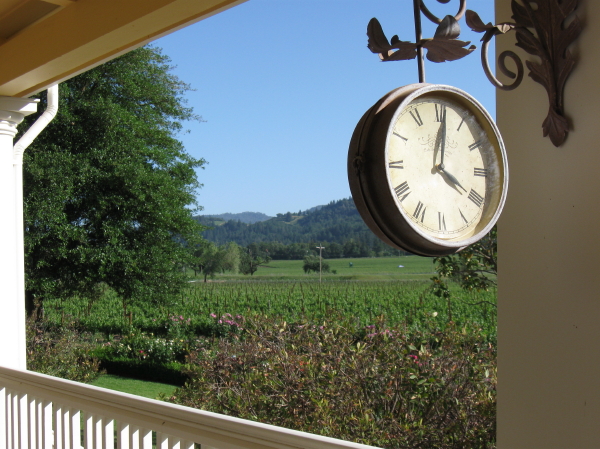
As the month of August launched this past week, more than one person lamented about the fact that summer is almost over. I, too, shared this sentiment and the cool crisp morning breezes in Napa Valley served as a reminder that autumn is right around the corner. Not wanting to give up its throne, however, summer has delivered warm sunny afternoons with enough heat to still demand summertime wines. Taking advantage of these final weeks of summer, I have been spending time in my vegetable garden with the plan to plant another crop of lettuces to enjoy throughout the fall. After spending a good portion of my day in my sunny vegetable garden, it was only natural that I would enjoy a mid-afternoon lunch out on the patio with a crisp, light refreshing Rosé.
Rosé is made from red skinned grapes but in a manner such that only a hint of color is in the wine, typically being a pink color but of varying intensities and can even have a slightly orange tint depending upon the method and the grapes used to make the Rosé. There are three (3) ways to make Rosé: (i) skin contact; (ii) saignée; and (iii) blending. “Skin contact” method involves crushing red skin grapes and only allowing the grape skins to have contact with the juice for a brief period of time. The grape skins contain tannins and other compounds which affect the flavoring of the wine. If this first method is used, the Rosé will taste more like a white wine. The second and more popular method of making Rosé in Napa Valley is “Saignée”. When the winemaker wants to give his or her Rosé more flavor or color, he or she will choose this method because it involves bleeding the juice from the “must”. “Must” is freshly pressed grape juice which contains seeds, grape skins and stems of the fruit. The grape juice is removed from the “must” at an early stage and reserved to make Rosé wine, showing that classic pink coloring. The third method of making Rosé is “Blending” and is the least common of the three. This method is to mix red wine with white wine in order to impart color to the resulting Rosé. This last method is typically only reserved for making Rosé sparkling wines.
Aside from the different methods of making Rosé, not all Rosés are created equally as the winemaker has latitude in selecting which grapes to use for making the wine. Often people think to zinfandel-based Rosés, but tasting throughout Napa Valley you will come across Rosés made from a variety of grapes which include Pinot Noir, Cabernet Franc, Syrah, and Sangiovese. To give you an idea of the diversity in Rosés, I decided this week to pick four (4) stand-outs.
But wait… what food do we pair with Rosés?
The great and fun aspect of Rosé is that you can pair a wide variety of easy summertime fare: burgers, salads, light appetizers, and sandwiches. Given that I want to distinguish the differences among four wines, I decided to create and pair a sandwich specifically tailored for that Rosé wine. Below follows the menu of sandwiches and the wine paired with each:
1) Roast Beef with Swiss Cheese, Homemade Bread and Butter Pickles, Garden Fresh Butter Lettuce, and Blue Cheese Dressing on Toasted Wheat Bread (“Roast Beef Sandwich”) accompanied by Sequoia Grove Vineyard’s (“Sequoia Grove”) Rollicking Rosé;
2) Seasoned Tri-Tip Steak with Swiss Cheese, Roasted Red Peppers, Garden Fresh Spicy Mesclun Lettuce Mix and Champagne Shallot Mustard on Toasted Wheat Bread (“Steak Sandwich”) accompanied by Peju Province Winery’s (“Peju”) Provence;
3) Honey Ham with Swiss Cheese, Avocado, Garden Fresh Tomato, Garden Fresh Summercrisp Lettuce and Champagne Shallot Mustard on Toasted Rye Bread (“Ham Sandwich”) accompanied by Benessere Vineyards’ (“Benessere”) Rosato; and
4) Grilled Fresh Mozzarella Cheese with Apricot and Balsamic Vinegar on Sourdough Bread (“Grilled Apricot Mozzarella Cheese Sandwich”) accompanied by Elyse Winery’s (“Elyse”) Rose.
Sequoia Grove makes a unique wonderful Rosé called “Rollicking” and loves to assure you that with this wine you will have a “rollicking good time.” Indeed this Rosé has spunk and attitude because it is made from one hundred percent (100%) Syrah grapes. On the nose, you will find strawberries, raspberries and a hint of kiwi. As this wine rolls back across the palate, you discover a juicy Rosé bursting with berries, yet still maintaining a dry style. The strawberries and raspberries from the bouquet follow through on the palate, adding in a hint of spice. Because it is made from Syrah grapes, this Rosé has more “backbone” and can stand up to a wide array of foods. It held up exceptionally well to the juicy rich Roast Beef Sandwich that I created. My five year-old neighbor wanted to share some Butter Lettuce that her family was growing and I knew that this sandwich would make good use of her generosity. The blue cheese dressing in the sandwich welcomed this Butter Lettuce, creating a soft velvety texture with the rich flavors of the dressing. Adding roast beef and semi-sweet homemade bread and butter pickles created a festive combination of flavors and spices that invited the lightly chilled Rollicking Rosé to maintain its identity, yet allowed it to simultaneously be in perfect balance with the rest of the sandwich. This past weekend, Sequoia Grove rumored that there are only five (5) cases of this Rollicking Rosé left at its winery. If you are in Napa Valley, I recommend stopping by to pick up a bottle because it will not be back until March of 2010.
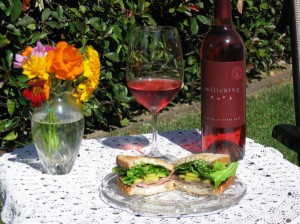
Peju creates a blend wine called “Provence” that at first blush is viewed by many as a Rosé. Like Rosés, it is meant to be served lightly chilled, but as opposed to being made from one hundred percent (100%) of a red wine grape and from the popular “Saignée” method, this wine is blended and comprised of fifty-five percent (55%) of Peju’s Proprietary Red wine and forty-five percent (45%) white wine. As stated above, this blending method is not common for Rosés in the United States and is typically reserved for sparkling Rosé wine. Its coloring is an illusion in the sense that it is a deep sparkling ruby hue yet as you taste it, your palate is met with flavors of fresh ripe red fruit, such as strawberries, cranberries, and cherries. These flavors are slightly richer than other Rosé wines, yet the white wine in the blend conveys a sense of refreshment on a hot afternoon. This Rosé will hold up to more substantial summer cuisine such as the Steak Sandwich that I created. Take a bite of roasted red peppers and seasoned tri-tip steak with a sip of Provence and you will quickly realize that this wine has met its match. The Provence also matches well with spicy flavorful lettuces such as Mesclun.
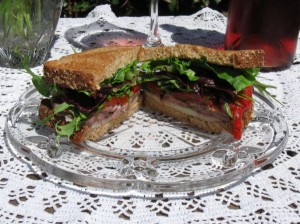
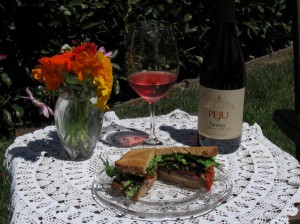
Benessere creates a Rosé called “Rosato”. The 2008 Rosato is made in accordance with the “Saignée” method and is made with 71% Sangiovese and 29% Merlot. Its coloring is a deep pink hue with refreshing nuances of watermelon, kiwi fruit and strawberry on both the nose and the palate. On a hot afternoon, this sweet Rosé truly refreshes and pairs better with lighter summer sandwiches, such as the Ham Sandwich that I created. The sweet fruit in the wine accentuates the honey in the ham and the champagne shallot mustard in the sandwich. The juicy ripe slice of garden fresh tomato is compatible to the juicy aspects found in the Rosato which would be primarily attributable to its Sangiovese component.
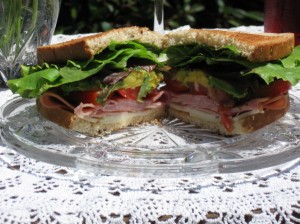
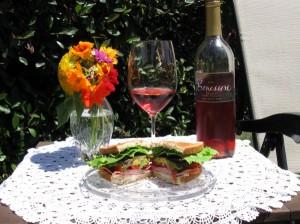
The fourth Rosé introduced is made by Elyse. Elyse has truly captured the dry style of Rosé characteristic of wines made in France. Most Rosé made in California tends to have a sweeter almost juicy flavor which does not mirror the traditional French style. Elyse, however, is the exception in that their winemaker has captured this true elegant dry style. Also, Elyse is unique with its Rosé as it is composed of fifty-six percent (56%) Valdiguié, thirty-four percent (34%) Carignane and the remainder is comprised of various percentages of grapes such as Grenache and Mourvèdre, among others. Having low alcohol content at 12.8%, this Rosé can serve as an easy going afternoon guest at a luncheon affair. On the nose, you will find a faint hint of strawberry and aroma of melon. While these flavors follow on the palate, there is also a light flavor of rhubarb which invokes thoughts of summer. When first tasting Elyse’s Rosé, food pairing may seem like a challenge, but there is a wide array of compatible summer light fare: light sandwiches, cucumber slices topped with crab salad spread, grilled fish tacos, and salads. Wanting to stay in line with my sandwich pairing theme for this article, I elected to create the Grilled Apricot Fresh Mozzarella Cheese Sandwich. This is a unique sandwich which proves that apricots do have some versatility. Apricots have a slight tart flavor, but when heated, the sugar and juice runs to blend with the sour flavors in the fresh sourdough bread used. Also, I drizzled a bit of balsamic vinegar on the inside of my peeled apricots and placed the vinegar side down on the slices of fresh mozzarella. As the sandwich heats, the balsamic vinegar caramelizes a bit to tie to the flavors of the heated apricot and ultimately give the flavors in the sandwich a bit of depth. Ultimately, any remaining tart flavors of the apricot are enveloped by the warm milky flavor of melted fresh mozzarella. While I could have added caramelized sweet onions to this sandwich, I elected instead to include a side of Sweet Onion Potato Chips. The sweet onion is another flavor that suits this sandwich and wine pairing well. Taking a bite into this sandwich, the sweet warm juice of ripe apricot drizzles down your hand and takes the concept of comfort food to a whole new level. When paired with the wine, this sandwich gives the semi-tart aspect found in this Rosé its respectful place on the palate.
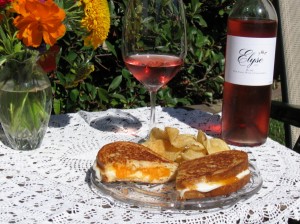
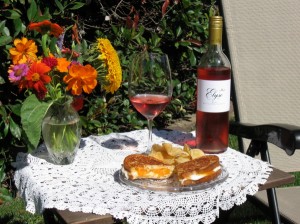
The next time you are wine tasting and about to pass on a Rosé, take a chance and get to know that winery’s individual winemaking style. Rosés are truly varied and many are quite good on a hot summer day. Few are truly “pink” these days as many host deeper hues suggestively akin to the red grapes that compose Rosés. The alcohol content of Rosé wines generally is relatively low and equally low is their price. With all this in mind, there is no need to “blush” when someone brings out a festive Rosé on a warm summer day.
*Are you on Facebook? Become a Fan of “The Casual Connoisseur”. Learn where I am wine tasting in Napa Valley and about quick weekend fun culinary ideas not featured on the web site. Cheers!
Comments Off on Time for Wine? Roll out the Rosés!